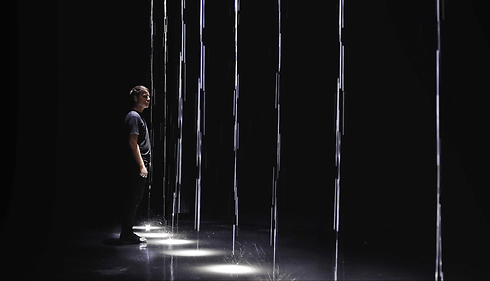
1 drop 1000 years at Festival ]interstice[
05.12.2025 ésam Caen/Cherbourg
Caen (F)
1 DROP 1000 YEARS - Scientists agree that a drop of water travels the globe in less than 1,000 years. This drop shapes our world: it transports nutrients, heat and living organisms, while regulating our planet's climate and ecosystems. It contributes to the fundamental process of life's equilibrium.
Drawing on data from the Global Conveyor Belt, the vast ocean current that orchestrates the mixing of water from the five oceans and redistributes heat on a global scale, Martin Messier underlines the fundamental role of water as a vital substance. Yet, over the past two centuries, human action has been shaking this fragile balance: the gradual slowing of this ocean current could trigger a major climatic upheaval, threatening the entire chain of life.
In this hypnotic performance, the artist explores the tensions between the global currents that drive planetary equilibrium, and the intimate currents that resonate within each of us. Fifteen suspended devices, veritable kinetic sculptures, orchestrate the flow of water particles in real time, materializing oceanic dynamics. The patterns generated, fed by data such as the temperature and salinity of the Pacific Ocean, intertwine in a visual and sonic choreography. 1 drop 1000 years reveals itself as a masterful, poetic ballet, conveying the fragility of ecosystems and the delicate harmony that binds all things on Earth.

1 Drop 1000 Years at IN-Sonora
23.11.2025 - 24.11.2025 Réplika Teatro & Real Conservatorio Superior de Música de Madrid
Madrid (ES)
At the occasion of the 20th anniversary of IN-SONORA Martin Messier will perform 1 DROP 1000 YEARS at Réplika Teatro in Madrid (ES) on 23 November 2025.
Martin Messier will also give a Masterclass on 24 November 2025 from 19:00 until 21:00 at the Real Conservatorio Superior de Música de Madrid. Attendees will have the opportunity to meet a key figure in the international art scene, who will share his work and process.
His performance art and ability to combine technologies with natural elements (water, smoke, waves, electricity, etc.) have led him to develop a body of work that explores our perception of physical phenomena. He explores their manifestations, from the most imperceptible to the most monumental, through extraordinary devices. His performances and installations oscillate between order and chaos, creating a contemplative tension that invites the audience to a synesthetic experience, sometimes bordering on the spiritual.
Martin Messier
IN-SONORA - 1 DROP 1000 YEARS
IN-SONORA - Masterclass
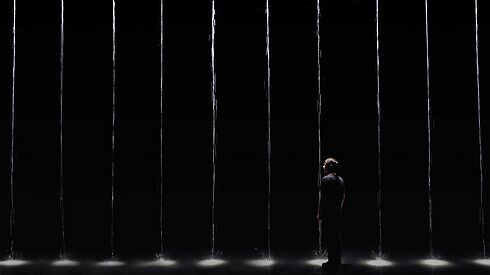
1 drop 1000 year at MUTEK JAPAN
20.11.2025 MUTEK Japan
Tokyo (JP)
1 DROP 1000 YEARS - Scientists agree that a drop of water travels the globe in less than 1,000 years. This drop shapes our world: it transports nutrients, heat and living organisms, while regulating our planet's climate and ecosystems. It contributes to the fundamental process of life's equilibrium.
Drawing on data from the Global Conveyor Belt, the vast ocean current that orchestrates the mixing of water from the five oceans and redistributes heat on a global scale, Martin Messier underlines the fundamental role of water as a vital substance. Yet, over the past two centuries, human action has been shaking this fragile balance: the gradual slowing of this ocean current could trigger a major climatic upheaval, threatening the entire chain of life.
In this hypnotic performance, the artist explores the tensions between the global currents that drive planetary equilibrium, and the intimate currents that resonate within each of us. Fifteen suspended devices, veritable kinetic sculptures, orchestrate the flow of water particles in real time, materializing oceanic dynamics. The patterns generated, fed by data such as the temperature and salinity of the Pacific Ocean, intertwine in a visual and sonic choreography. 1 drop 1000 years reveals itself as a masterful, poetic ballet, conveying the fragility of ecosystems and the delicate harmony that binds all things on Earth.
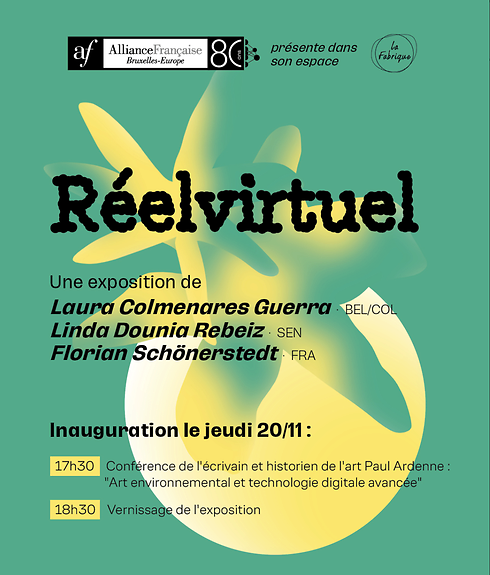
Topography of a second & Ooloi Flora
20.11.2025 - 04.02.2026 La Fabrique – Alliance Française Bruxelles-Europe
Brussels (B)
Every year, the Institut français and the French cultural network abroad celebrate digital arts and culture as part of Novembre Numérique.
To mark the occasion, the Alliance Française de Bruxelles-Europe is inaugurating a new exhibition at La Fabrique: RÉELVIRTUEL. A unique encounter between art, cutting-edge digital technology and environmental awareness.
Three artists with different but complementary approaches: Laura Colmenares Guerra, Linda Dounia Rebeiz and Florian Schönerstedt explore together the possibilities of ‘réelvirtuel’ art, according to the expression coined by writer and art historian Paul Ardenne.
The opening will be held on Thursday, 20 November 2025 at 18:30 at La Fabrique, the cultural center of the Alliance Française de Bruxelles-Europe.
Register here for the opening
From 17:30 to 18.30 the opening will be preceded by a conference by art critic and historian Paul Ardenne in connection with the themes of the exhibition: Environmental art and advanced digital technology.
Register here for the conference
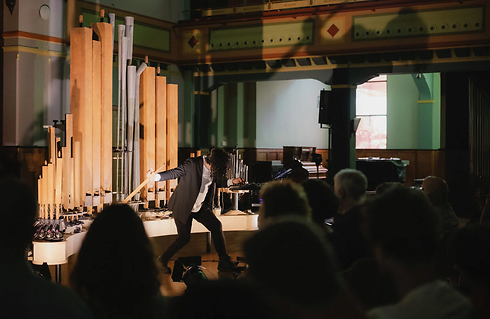
Navid Navab Winner Lumen Prize 2025 Identity & Culture Award
08.11.2025 Kunstsilo
Kristiansand (NO)
"Informed by my experience as a queer Iranian-Canadian artist, I steer away from idealized forms of digital expression driven by military-cybernetic agendas aimed at controlling nature. For me, queering generative algorithms means re-centering their expressive dynamics in bodily relation, in movement, and in time—at the very core of nature’s uncontrollable creativity.
This work traces the non-idealized, pre-mathematical, and kinetic source of today's generative algorithms (ie. vector synthesis, stochastic music, AI music). I use digital media to collaborate with excitable tendencies of matters-of-process, suspended in metastable-states, where thermodynamic-reservoirs-of-indeterminacy generate cybernetic-intentionality. “Organism: In Turbulence” (performance) destabilizes the socio-historical tonality of a 1910 Casavant pipe-organ, rescued from the impending gentrification at a heritage site in Montreal, to liberate and sound its turbulent materiality, robotically unleashing long-silenced timbres after centuries of sonic repression.-
During concerts, shifting metastable states allow for energetic thresholds to fall into and out of compatibility with one another. Navab shapes this ecology of interdependent timbres into emergent realms, traversing microsonic-polyrhythms, post-rock overspill and swampy-soundscapes. In the installation version, Organism + Excitable Chaos (created in collaboration with Garnet Willis), the chaotic motion of Excitable Chaos, a robotically-steered triple pendulum, drives the aerodynamic thresholds of Organism, the robotically-prepared century-old pipe organ.
The generative movement of Excitable Chaos conducts Organism’s aerodynamic thresholds, and in this way draws kinetic-chaos into conversation with sonic-turbulence. The resulting turbulent-sonifications-of-chaos serve as meditations on how a cascading sense of more-than-oneness may spontaneously develop in life and nature and how this wild yet steerable relationality can help us in co-expressing worlds yet unknown." - Navid Navab
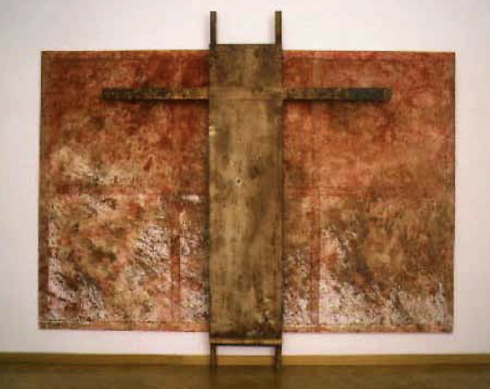
Reliktinstallation 6-Tage-Spiel 1998 in Faith No More. Rituals for Uncertain Times.
24.10.2025 - 01.03.2026 Abby
Kortrijk (B)
Faith No More. Rituals for Uncertain Times is an exhibition about apocalyptic thinking, despair, hope, and consolation in the Middle Ages and today, featuring live work by Tino Sehgal in de Kapel and works by Hermann Nitsch, Marina Abramović, Francis Alÿs, Joseph Beuys, Michaël Borremans, Miriam Cahn, Lucas Cranach I, Thierry De Cordier, Albrecht Dürer, Marlene Dumas and many others in the galleries.
We are living in uncertain times. Climate change, wars, tensions between countries, rapid technological shifts and social unrest leave many feeling lost. At times, it seems as though we are sliding into an apocalyptic vision of the future. This echoes the late Middle Ages, when people saw their world as chaotic, threatening and unstable — and surrendered to higher powers in search of guidance.
For centuries, religion offered a framework to understand life. It provided direction and comfort, but also imposed dogmas and exclusion. Faith was the way to create order in an often incomprehensible reality. Today, that self-evident role of religion has largely disappeared. We live in a secular and fragmented society. Where do we now find new forms of grounding, connection and hope? How do we give our fears and desires a place?
This exhibition departs from that search. It shows how artists, past and present, grapple with uncertainty and fear, how they shape grand narratives and intimate rituals, and how art can offer new perspectives for collective grounding. Perhaps the key to our time lies not in ready-made answers, but in searching, experiencing, and imagining together what it means to be human in a world full of change.
Descend into the underground galleries and immerse yourself in late medieval and contemporary art about doom and dawn, despair and consolation. Above ground, in de Kapel, live work by Tino Sehgal awaits you — a transitional ritual between the world inside and the world outside. A sensory and emotionally charged experience that cannot be captured on camera: what remains is only your memory — intimate, temporary, and unrepeatable.
Faith No More. Rituals for Uncertain Times is curated by Sarah Keymeulen and Klara Rowaert in collaboration with co-curator Kendell Geers.
Hermann Nitsch
Faith No More. Rituals for Uncertain Times
Abby Kortrijk
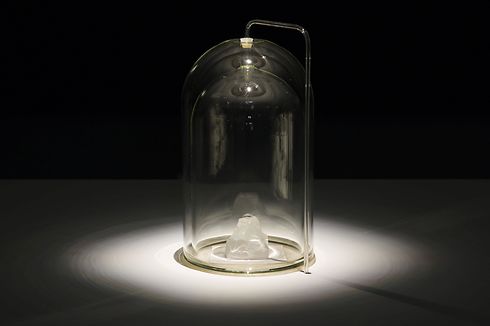
Tipping Point in "Migrations et Climat"
17.10.2025 - 05.04.2026 Palais de la Porte Dorée
Paris (F)
The installation Tipping Point by Barthélemy Antoine-Loeff is a sensitive and poetic tribute to those dying glaciers. It stages the (re)birth of an artificial glacier protected by a dome; a drip is feeding the glacier that will grow during the exhibition. The device invites the viewer to attend the birth of this artificial glacier. It is inspired by the “ice stupas” invented by the engineer Sonam Wangchuk and used to fight against water shortages during the summer in Ladakh.
Between a laboratory experiment, an attempt to repair the climate or an ironic collector’s item, the installation confronts us with time and scales; 10.000 years ago, the stabilisation of our cryosphere coincided with the first human traces we found in Mesopotamia, while the fist glaciers are disappearing in 70 years under the pressure of the human activity.
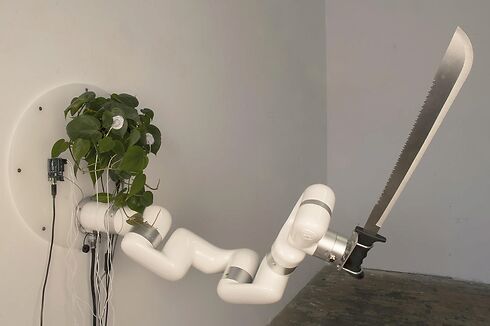
plant machete in Other Intelligences
10.10.2025 - 23.11.2025 MU Hybrid Art House
Eindhoven (NL)
What forms of intelligence are there? What significance do they play in our understanding of ecology and society? With Other Intelligences a group of twelve international artists delves into the different forms of intelligence: artificial, technological, but also the organic one of flora and fauna in their interactions within an ecosystem.
The artists investigate what intelligence can be in the age of artificial intelligence (AI) and what other forms of nonhuman intelligence could be relevant in forging our future. They explore how the synthetic brain of an artificial intelligence operates or how organisms from the animal and plant world sense and act, and what we can learn from other such intelligences.
So, what do ChatGPT and the rainforest have in common? Both are currently much discussed social issues. They represent the two areas, namely AI and the climate crisis, whose development will have a radical impact on the future of humanity. They are also representatives of two different, non-human systems of intelligence. In the exhibition we are seeking to examine both these aspects of non-human intelligence, as understanding of and empathy for other forms of intelligence are becoming the most important survival strategies for our species.
Curated by Sabine Himmelsbach, Marlene Wenger and Angelique Spaninks
This installation by David Bowen enables a live plant to control a machete. plant machete has a control system that reads and utilizes the electrical noises found in a live philodendron. The system uses an open source micro-controller connected to the plant to read varying resistance signals across the plant’s leaves. Using custom software, these signals are mapped in real-time to the movements of the joints of the industrial robot holding a machete. In this way, the movements of the machete are determined based on input from the plant. Essentially the plant is the brain of the robot controlling the machete determining how it swings, jabs, slices and interacts in space.
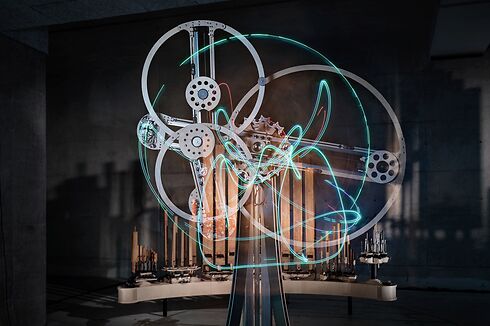
Organism + Excitable Chaos
08.10.2025 - 11.10.2025 Prisma Festival
Igreja das Carmelitas, Aveiro (PT)
Organism + Excitable Chaos
A robotically prepared historic pipe organ driven by a robotically-steered chaotic pendulum
The chaotic motion of Excitable Chaos, a robotically‑steered triple pendulum, drives the aerodynamic thresholds of Organism, a robotically‑prepared century‑old pipe organ.
Organism dismantles the socio‑historical tonality of the organ—civilization’s triumph over the turbulence of nature—to liberate and sound its hidden turbulent materiality. A 1910 Casavant pipe organ, rescued from a heritage site in Montréal, has its pneumatic architecture modified to remove aerodynamic stabilizations that once aimed to eliminate turbulent flow and its uncontrollable sound world, allowing long‑repressed timbres to be heard anew.
Excitable Chaos is a nonlinear movement system animated by the dynamic exchange of potential and kinetic energy across its three interconnected arms. Occasionally, by modulating its pivotal joints and damper weights, it alters the mass‑orbital relationships of its arms, generating distinct movement systems—each a stochastic universe unto itself. Pivotal joints shift the system’s gravitational dynamics, while subtle adjustments to damper weights refine its resonances, phases, and grooves.
These transductive modulations enable the artist to collaborate with chaos—nature’s form‑giving engine—highlighting how even the subtle fluctuations at the smallest of scales are key contributors to the emergence of cohesive behavior, whose next state remains unknowable.
Excitable Chaos’s transductive dance with gravity—its energetic tensions, correlations, and upheavals continuously shaping and unshaping excitable worlds—is sensed and data‑sculpted to reveal its inner liveliness. This multivariate stream of dynamic data, extracted from Excitable Chaos’s generative movement, is mapped onto Organism’s aerodynamic thresholds, conducting its sonic behavior and thus drawing kinetic chaos into dialogue with sonic turbulence. Each undulation opens an indeterminate cycle of cascading oscillations, while chaotic attractors establish self‑similar grooves over time.
The resulting turbulent sonifications of chaos serve as meditations on the spontaneous emergence of more‑than‑oneness in life and nature, and how this wild yet steerable relationality can help us co‑express worlds yet unknown.

1 Drop 1000 Years at Sonica Istanbul
02.10.2025 Babylon Istanbul
Istanbul (TR)
Sonica is heading to Istanbul for the first time. For four days, audiences in the city’s heart will encounter the bold, boundary-pushing spirit that has established Sonica as an international leader in sonic and visual art.
1 DROP 1000 YEARS - Scientists agree that a drop of water travels the globe in less than 1,000 years. This drop shapes our world: it transports nutrients, heat and living organisms, while regulating our planet's climate and ecosystems. It contributes to the fundamental process of life's equilibrium.
Drawing on data from the Global Conveyor Belt, the vast ocean current that orchestrates the mixing of water from the five oceans and redistributes heat on a global scale, Martin Messier underlines the fundamental role of water as a vital substance. Yet, over the past two centuries, human action has been shaking this fragile balance: the gradual slowing of this ocean current could trigger a major climatic upheaval, threatening the entire chain of life.
In this hypnotic performance, the artist explores the tensions between the global currents that drive planetary equilibrium, and the intimate currents that resonate within each of us. Fifteen suspended devices, veritable kinetic sculptures, orchestrate the flow of water particles in real time, materializing oceanic dynamics. The patterns generated, fed by data such as the temperature and salinity of the Pacific Ocean, intertwine in a visual and sonic choreography. 1 drop 1000 years reveals itself as a masterful, poetic ballet, conveying the fragility of ecosystems and the delicate harmony that binds all things on Earth.